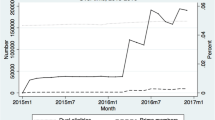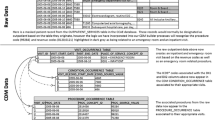Abstract
Background: Dual-eligible Medicaid-Medicare beneficiaries represent a group of people who are in the lowest income bracket in the US, have numerous co-morbidities and place a heavy financial burden on the US healthcare system. As cost-effectiveness analyses are used to inform national policy decisions and to determine the value of implemented chronic disease control programmes, it is imperative that complete and valid determination of healthcare utilization and costs can be obtained from existing state and federal databases. Differences and inconsistencies between the Medicaid and Medicare databases have presented significant challenges when extracting accurate data for dual-eligible beneficiaries.
Objectives: To describe the challenges inherent in merging Medicaid and Medicare claims databases and to present a protocol that would allow successful linkage between these two disparate databases.
Methods: Healthcare claims and costs were extracted from both Medicaid and Medicare databases for King County, Seattle, WA, USA. Three Medicaid files were linked to eight Medicare files for unique dual-eligible beneficiaries with type 2 diabetes mellitus.
Results: Although major differences were identified in how variables and claims were defined in each database, our method enabled us to link these two different databases to compile a complete and accurate assessment of healthcare use and costs for dual-eligible beneficiaries with a costly chronic condition. For example, of the 1759 dual-eligible beneficiaries with diabetes, the average cost of healthcare was $US15 981 per capita, with an average of 76 claims per person per year.
Conclusion: The resulting merged database provides a virtually complete documentation of both utilization and costs of medical care for a population who receives coverage from two different programmes. By identifying differences and implementing our linkage protocol, the merged database serves as a foundation for a broad array of analyses on healthcare use and costs for effectiveness research.




Similar content being viewed by others
References
Kasper J, Elias R, Lyons B. Dual eligibles: Medicaid’s role in filling Medicare’s gaps. Kaiser Commission on Medicaid and the Uninsured Issue Paper 2004 Mar [online]. Available from URL: http://www.kff.org/medicaid/upload/Dual-Eligibles-Medicaid-s-Role-in-Filling-Medicare-s-Gaps.pdf [Accessed 2008 Nov 11]
Centers for Medicare and Medicaid Services. Medicare and Medicaid statistical supplement 2004 [online]. Available from URL: http://www.cms.hhs.gov/MedicareMedicaidStatSupp [Accessed 2008 Nov 11]
Holahan J, Ghosh A. Dual eligibles: Medicaid enrollment and spending for Medicare beneficiaries in 2003. Kaiser Commission on Medicaid and the Uninsured Issue Paper 2005 Jul [online]. Available from URL: http://www.kff.org/medicaid/upload/7346%20Dual%20Eligibles_Enrollment%20and%20Spending_Beneficiaries_Final_revised%207_28.pdf [Accessed 2008 Nov 11]
Cubanski J, Voris M, Kitchman M, et al. Medicare chartbook, third edition. Menlo Park (CA): The Henry J. Kaiser Family Foundation, 2005 [online]. Available from URL: http://www.kff.org/medicare/upload/Medicare-Chart-Book-3rd-Edition-Summer-2005-Report.pdf [Accessed 2008 Nov 11]
Nemore P. Dual eligibles. Issue Brief Cent Medicare Educ 2004; 5 (2): 1–6
Ryan J, Super N. Dually eligible for Medicare and Medicaid: two for one or double jeopardy? Issue Brief Natl Health Policy Forum 2003; 794: 1–23
Sloss EM, Dhanani N, O’Leary JF, et al. Inpatient utilization by dual Medicare-Medicaid eligibles in Medicare risk HMOs and fee for service California, 1991–1996. Manag Care Interface 2004; 17 (12): 30–4
Wolfe J, Proctor SP, Erickson DJ, et al. Risk factors for multisymptom illness in US Army veterans of the Gulf War. J Occup Environ Med 2002; 44 (3): 271–81
Baugh DK, Pine PL, Blackwell S, et al. Medicaid prescription drug spending in the 1990s: a decade of change. Healthcare Financ Rev 2004; 25 (3): 5–23
Freburger JK, Konrad TR. The use of federal and state databases to conduct health services research related to physical and occupational therapy. Arch Phys Med Rehabil 2002; 83 (6): 837–45
Chan L, Houck P, Prela CM, et al. Using Medicare databases for outcomes research in rehabilitation medicine. Am J Phys Med Rehabil 2001; 80: 474–80
Fisher ES, Wennberg DE, Stukel TA, et al. The implications of regional variations in Medicare spending: part l. The content, quality, and accessibility of care. Ann Int Med 2003; 138: 273–87
Jencks SF, Cuerdon T, Burwen DR, et al. Quality of medical care delivered to Medicare beneficiaries: a profile at state and national levels. JAMA 2000; 284 (13): 1670–6
McCandless RR. Attributing inpatient Medicare costs to diabetes among the Texas elderly. Diabetes Care 2002; 25: 1958–63
Tseng CL, Greenberg JD, Helmer D, et al. Dual-system utilization affects regional variation in prevention quality indicators: the case of amputations among veterans with diabetes. Am J Manag Care 2004; 10 (2): 886–92
Mark TL, Axelsen KJ, Mucha L, et al. Racial differences in switching, augmentation, and titration of lipid-lowering agents by Medicare/Medicaid dual-eligible patients. Am J Manag Care 2007; 13: S72-S79
McFarland LV, Reiber GE, Norman JE. Recruitment of Medicaid and dual-enrolled Medicare beneficiaries with diabetes mellitus into a randomized controlled trial. Am J Manag Care 2005; 11 (7): 443–8
Centers for Medicare and Medicaid Services. Program information on Medicaid and State Children’s Health Insurance Program (SCHIP). 2004 [online]. Available from URL: http://www.cms.hhs.gov/MedicaidGenInfo/05_SCHIP%20Information.asp [Accessed 2008 Nov 11]
Hogan P, Dall T, Nikolov P, et al. Economic costs of diabetes in the US in 2002. Diabetes Care 2003; 26 (3): 917–32
Finkelstein EA, Bray JW, Chen H, et al. Prevalence and costs of major depression among elderly claimants with diabetes. Diabetes Care 2003; 26 (2): 415–20
Burton LC, Weiner JP, Stevens GD, et al. Health outcomes and Medicaid costs for frail older individuals: a case study of a MCO versus fee-for-service care. J Am Geriatr Soc 2002; 50 (2): 382–8
Foote SM. Population-based disease management under fee-for-service Medicare. Health Aff (Millwood) 2003, Jul-Dec (Suppl Web Exclusives): W3–342-356
Hebert PL, Geiss LS, Tierney EF, et al. Identifying persons with diabetes using Medicare claims data. Am J Med Qual 1999; 14 (6): 270–7
Prela CM, Smilie JG, McInerney MJ, et al. Direct mail intervention to increase retinal examination rates in Medicare beneficiaries with diabetes. Am J Med Qual 2000; 15: 257–62
Sambamoorthi U, Collins S, Crystal S. Dually eligible individuals with AIDS: characteristics and health services use. J Health Soc Policy 2001; 14:19–35
Reiber GE, Norman JE, McFarland LV. Efficacy of diabetes health enhancement program in a Medicaid population with diabetes: a randomized controlled trial. American Diabetes Association Meeting; 2004 Jun 4–8; Orlando (FL)
McCall DT, Sauaia A, Hamman RF, et al. Are low-income elderly patients at risk for poor diabetes care? Diabetes Care 2004; 27 (5): 1060–5
Anderson WL, Norton EC, Dow WH. Medicare maximization by state Medicaid programs: effects on Medicare home care utilization. Med Care Res Rev 2003; 60 (2): 201–2
Iezzoni LI, Foley SM, Daley J, et al. Comorbidities, complications, and coding bias: does the number of diagnosis codes matter in predicting in-hospital mortality? J Am Med Assoc 1992; 267: 2197–203
Hennessy S, Bilker WB, Weber A, et al. Descriptive analyses of the integrity of a US Medicaid claims database. Pharmacoepidemiol Drug Saf 2003; 12 (2): 103–11
Chattopadhyay A, Bindman AB. Accuracy of Medicaid payer coding in hospital patient discharge data: implications for Medicaid policy evaluation. Med Care 2005; 43 (6): 586–91
Acknowledgements
The analyses upon which this publication is based were performed under contract number 500-99-WA02, funded by the Centers for Medicare & Medicaid Services, an agency of the US Department of Health and Human Services. Additional funding was from the Sandy MacColl Foundation, Seattle, Washington; The Robert Wood Johnson Foundation, Princeton, New York; Adventis Pharmaceuticals Inc. and Washington State Department of Health.
The views expressed in this article are those of the authors and do not necessarily reflect the position or policy of the Department of Veterans Affairs or the Department of Health and Human Services. The authors assume full responsibility for the accuracy and completeness of the ideas presented.
Author information
Authors and Affiliations
Corresponding author
Rights and permissions
About this article
Cite this article
Prela, C.M., Baumgardner, G.A., Reiber, G.E. et al. Challenges in Merging Medicaid and Medicare Databases to Obtain Healthcare Costs for Dual-Eligible Beneficiaries. Pharmacoeconomics 27, 167–177 (2009). https://doi.org/10.2165/00019053-200927020-00007
Published:
Issue Date:
DOI: https://doi.org/10.2165/00019053-200927020-00007




